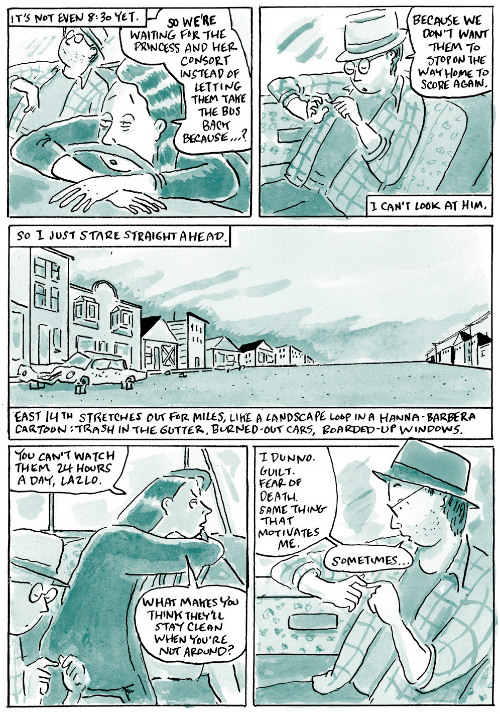
The Customer Is Always Wrong, the latest graphic novel from Mimi Pond, follows her 2014 book Over Easy. Inspired by Pond’s own experiences as a young artist working in an Oakland restaurant in the late 1970s and early 1980s. Pond neatly captures a host of facets of human experience, from protagonist Madge’s creative evolution to the shifting dynamics of her workplace to a series of harrowing drug-fueled misadventures. Pond will be in conversation with Todd Oldham at Fishs Eddy — which has also released a line of items inspired by her work — on Wednesday, September 6. In advance of that, I asked her some questions about revisiting early-80s Oakland, the emotional range of The Customer Is Always Wrong, and more.
The Customer Is Always Wrong is a followup to your earlier Over Easy. How did you view the relationship between the two books, as far as telling one story over the course of both books versus each one standing on its own?
It was never my intention for this to be anything other than one continuous story. It is difficult for me to have the perspective to view it otherwise.
While Madge was at the center of Over Easy, The Customer Is Always Wrong occasionally veers into the stories that coincide with hers. When did the idea to open up this world come about?
I always perceived the story to be about all those people, not just Madge. She’s interesting but she’s only really interesting because she’s interested in this drama playing out before her. I always saw it as being about the struggles people in their 20s have with identity and maturity and decision-making.
Did you always have a sense of where one book would end and the other would begin?
Honestly, we only split the book in two parts because trying to gain any traction on finishing it was too daunting. I ended Over Easy where I did because it just seemed like the best place to break it off.

In the list of people you thank in the opening of The Customer Is Always Wrong, you mention that you talked with old coworkers about their memories of the time you’re writing about. How did that end up shaping the final form of the story?
It shaped it tremendously, because I left the restaurant before things really got that bad. I was corresponding with the real Lazlo and he was filling me in on the downward spiral. Later I interviewed a number of those coworkers and their tales were even more hair-raising. It was never my intention to write a non-fiction chronicle of the real events. I wanted to create a metaphor for what it seemed like, what it felt like.
The narrative of this book blends the same observational humor and attention to detail as its predecessor, but also heads into bleaker territory, with a number of subplots in which drugs and violence abound. How did you find the right balance between the two?
I wanted to give that sense of how much fun it really was- until suddenly it wasn’t funny anymore. You have to find that kind of momentum that crosses the threshold. It happens all the time in movies. I find film a great way to learn about pacing.
There’s a line late in the book about a “psychic wall between the writer and his psyche.” Given that this is a book inspired by your life, do you see that wall as illustrating the divide between reality and fiction within this particular narrative?
Yes, because in real life, there are plenty of small heartbreaking moments that you can chronicle and use, but real life is rarely so dramatic that you can lift it word for word.
Were there any notable stories from this part of your life in Oakland that didn’t make it into the final version of these two books?
Well, there was that time I was throwing up in front of a sign that said, “Talk To A Live Nude Girl,” in front of the Condor Club in San Francisco. When I woke up the next day on my fellow waitress’s living room floor, she was standing over me. She said, “I drove us home last night.” I said, “Good!” She said, “I don’t know how to drive.”
Photo: Lynda Burdick; Artwork: Mimi Pond, courtesy of Drawn & Quarterly
Follow Vol. 1 Brooklyn on Twitter, Facebook, and sign up for our mailing list.
